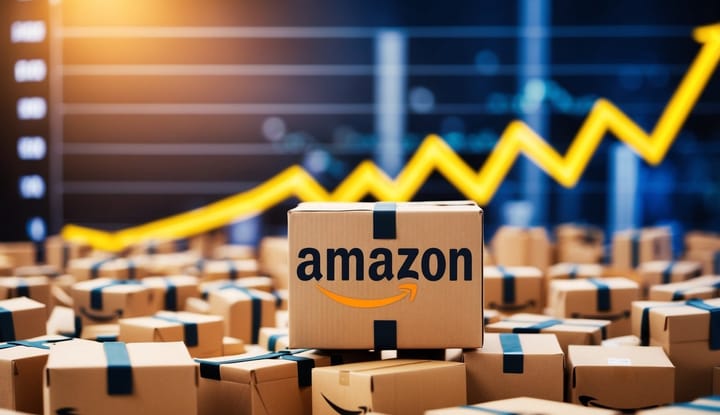Can Amazon Sellers Become Millionaires? Success Strategies

Many people wonder if selling on Amazon can lead to millionaire status. The truth is, some Amazon sellers have indeed become millionaires through their businesses.
These sellers often start small, identifying niche products or solving common problems for customers. They grow their businesses by reinvesting profits, expanding product lines, and mastering Amazon's algorithms.
While not every Amazon seller becomes a millionaire, the potential exists for those who approach it with dedication, strategy, and a willingness to adapt to market changes.
Success on Amazon requires more than just listing products. Top sellers focus on product quality, customer service, and smart marketing tactics. They also manage their finances carefully, balancing growth with profitability.
With the right approach and persistence, reaching millionaire status through Amazon selling is possible for some entrepreneurs.
Key Takeaways
- Some Amazon sellers have become millionaires by building successful online businesses
- Success on Amazon requires strategic product selection, quality offerings, and excellent customer service
- Careful financial management and reinvestment in growth are key factors for long-term profitability
Understanding the Amazon Marketplace
The Amazon marketplace offers sellers a huge platform to reach customers. Success depends on many factors, from product selection to marketing strategies. The marketplace has its own unique ecosystem that sellers must learn to navigate.
Factors That Affect Sales on Amazon
Product demand is key for Amazon sales. Popular items in growing categories tend to sell well. Pricing also matters a lot. Sellers need to price competitively while still making a profit. Good product listings with clear photos and descriptions help too.
Reviews play a big role in sales. Products with many positive reviews often rank higher in search results. Fast shipping is important as well. Many customers expect quick delivery.
Seasonal trends affect some products. Certain items may sell much better at specific times of year. Sellers should plan inventory around these patterns.
Analyzing Amazon's Seller Ecosystem
Amazon has millions of sellers competing for sales. Some are big brands, while others are small businesses. Third-party sellers now account for over half of Amazon's sales.
The marketplace has different types of sellers. Some only sell on Amazon. Others use it as one of many sales channels. There are also sellers who create their own branded products.
Competition can be fierce in popular categories. New sellers may struggle to stand out at first. Building a strong brand and customer base takes time.
Amazon's algorithms impact visibility. Products that sell well and have good metrics tend to rank higher. This can create a "rich get richer" effect for top sellers.
Creating a Successful Amazon Business
Building a thriving Amazon business takes careful planning and smart strategies. Sellers who succeed focus on key areas like product selection, efficient operations, and effective marketing.
Selecting the Right Niche and Products
Picking the right niche and products is crucial for Amazon success. Start by researching market trends and consumer needs. Look for items with good profit margins and low competition.
Use tools like Jungle Scout to analyze sales data and find promising opportunities. Consider products that solve problems or fill gaps in the market. Avoid oversaturated categories where it's hard to stand out.
Test different products on a small scale before investing heavily. Track performance metrics closely to see what sells best. Be ready to pivot if initial choices don't pan out.
Effective Use of Amazon FBA and Logistics
Amazon's Fulfillment by Amazon (FBA) service can streamline operations and boost sales. FBA handles storage, shipping, and customer service, freeing up time for business growth.
Calculate FBA fees carefully to ensure profitability. Compare costs with self-fulfillment options. Use Amazon's revenue calculator to estimate potential profits.
Optimize inventory management to avoid stockouts or excess stock. Set up automatic reordering systems. Consider using third-party logistics providers for added flexibility.
Track key metrics like inventory turnover and shipping times. Use this data to improve efficiency and cut costs.
Optimizing Listings and Influencer Marketing
Well-crafted product listings are key to attracting buyers. Use clear, detailed descriptions and high-quality images. Include relevant keywords to improve search visibility.
A/B test different titles, bullet points, and pricing to find what works best. Use Amazon's analytics tools to track listing performance and make data-driven improvements.
Leverage influencer marketing to boost visibility. Partner with social media personalities or niche experts to promote products. This can drive traffic and sales, especially for new or unique items.
Encourage customer reviews to build trust and improve rankings. Follow up with buyers to address any issues and ask for feedback.
Marketing and Scaling Your Amazon Presence
Effective marketing and scaling strategies are key for Amazon sellers aiming to grow their business. These approaches can boost visibility, drive traffic, and increase sales.
Harnessing the Power of Social Media
Social media platforms offer Amazon sellers valuable tools to reach new customers. Sellers can create engaging content showcasing their products and brand story.
Regular posts on Instagram, Facebook, and TikTok can build a loyal following. Sellers might share product photos, customer reviews, or behind-the-scenes peeks at their business.
Paid social ads can target specific audiences likely to be interested in a seller's items. This can drive traffic directly to Amazon product listings. Some sellers find success partnering with influencers to promote their products to a wider audience.
Social media also allows sellers to interact with customers directly. This can build trust and loyalty. Responding to comments and messages promptly shows good customer service.
Working with HARO
HARO (Help a Reporter Out) is a free service that connects journalists with expert sources. Amazon sellers can use HARO to get media coverage for their brand or products.
Sellers sign up as sources in their area of expertise. They then receive daily emails with journalist queries. When a relevant query comes up, sellers can send a pitch.
If chosen, they may be quoted in articles or news stories. This strategy takes time and effort, but can lead to valuable press mentions. Media coverage can increase brand awareness and lend authority to a seller's Amazon presence.
Expanding Beyond Amazon
While Amazon offers a huge customer base, smart sellers don't put all their eggs in one basket. Expanding to other platforms can boost revenue and reduce risk. eBay is a popular choice, with its own large customer base.
Sellers might also create their own website to sell directly to customers. This allows more control over branding and customer relationships. It can also lead to higher profit margins by cutting out marketplace fees.
Some sellers branch out into wholesale or brick-and-mortar stores. Others explore international markets through Amazon's global marketplaces. Diversifying sales channels can lead to more stable, long-term growth.
Financial Management for Long-Term Success

Smart money moves can make or break an Amazon seller's path to riches. Good budgeting and profit strategies are key, along with knowing how to handle fees and returns.
Maximizing Profits and Managing Budget
Sellers need to keep a close eye on their numbers. Tracking income and costs is crucial.
A budget helps plan for the future and avoid cash crunches. Smart sellers focus on profit margins, not just total sales. They look for ways to boost profits while cutting costs.
Buying inventory at good prices is important. So is setting the right sale prices. Sellers should check their profit margins often.
If margins are too low, they may need to find new suppliers or raise prices.
Some top sellers use special tools to track their finances. These tools can show which products make the most money. They also help spot areas where costs could be cut.
Navigating Amazon Fees and Returns
Amazon charges different fees for selling on their site. Sellers need to factor these into their prices.
There are fees for storing items in Amazon's warehouses. Sellers also pay when items sell.
Returns can eat into profits. Sellers should have a clear return policy and plan for some items coming back.
Good packaging can help reduce damage and returns.
Some sellers offer special deals to cut down on returns. They might give small discounts if buyers keep items. Others focus on great customer service to avoid returns in the first place.
Smart sellers keep track of their return rate. If it's high, they look for ways to fix the problem. This might mean changing product descriptions or improving quality.
Key Insights from Successful Amazon Entrepreneurs

Top Amazon sellers share common traits that lead to success. These entrepreneurs focus on product selection, customer service, and smart business practices.
The Role of Perseverance and Adaptability
Successful Amazon sellers don't give up when faced with challenges. They keep pushing forward, even during tough times like the pandemic.
These sellers adapt quickly to market changes and new Amazon rules.
Many top sellers started small and grew over time. They learned from mistakes and improved their strategies.
Some spent months or years refining their approach before seeing big profits.
Adaptability is key in the fast-paced world of e-commerce. Top sellers stay up-to-date with trends and adjust their product lines as needed. They also keep an eye on their metrics and make changes to boost performance.
Building a Supportive Team and Network
No Amazon millionaire succeeds alone. Smart sellers build strong teams to handle different parts of the business.
This might include product researchers, customer service reps, and marketing experts.
Networking with other sellers is also important. Successful entrepreneurs join seller groups and attend e-commerce events. They share tips and learn from each other's experiences.
Many top sellers also work with suppliers and logistics partners. These relationships help ensure steady product supply and smooth shipping. Some sellers even team up with other businesses to create new products or reach more customers.
Building a good team takes time and effort, but it pays off in the long run. It allows sellers to grow their businesses and increase profits.
Frequently Asked Questions

Many people wonder about the path to success as an Amazon seller. These questions cover key aspects of becoming a top earner on the platform.
What are the steps to becoming a successful seller on Amazon?
Start by researching products and niches. Choose items with good profit margins and low competition.
Create an Amazon seller account and list your products. Focus on excellent customer service and fast shipping. Get positive reviews to boost your visibility.
Keep learning and adapting your strategies as you grow.
How many sellers have achieved millionaire status through Amazon sales?
The exact number is not public. However, estimates suggest thousands of sellers make over $1 million in annual revenue on Amazon. This number grows each year as more people start selling on the platform.
What strategies do top earning Amazon sellers use to maximize profits?
Top sellers often use private label products to increase margins. They optimize product listings with great photos and descriptions. Many use Amazon's FBA program for efficient order fulfillment. Successful sellers also track data closely and adjust prices as needed. Some expand to multiple product categories or international markets.
How important is product selection in becoming a successful Amazon seller?
Product selection is crucial for success. Choose items with steady demand and not too much competition. Look for products you can source at low costs and sell at competitive prices. Consider seasonal trends and long-term viability. Good product choices can lead to higher sales and profits.
What common characteristics do millionaire Amazon sellers share?
Successful sellers are often very hardworking and persistent. They're willing to learn from mistakes and adapt quickly. Many have strong business and marketing skills. Top sellers usually reinvest profits to grow their business. They stay up-to-date on Amazon's policies and market trends.
What are the potential risks and challenges when trying to become a high-earning seller on Amazon?
Competition on Amazon is fierce. New sellers may struggle to stand out.
Product quality issues or negative reviews can hurt sales. Amazon's fees and rules can change, affecting profits.
Inventory management can be tricky, especially for popular items. Some sellers face issues with counterfeit products or hijacked listings.
Ready to start your own success story on Amazon?
Join our mini-course at WAH Academy and get clear, step-by-step guidance on launching your Amazon store the smart way. From picking products to setting up your first listing, we’ll help you start strong.
Tap the button and take the first real step toward building your Amazon business today.



